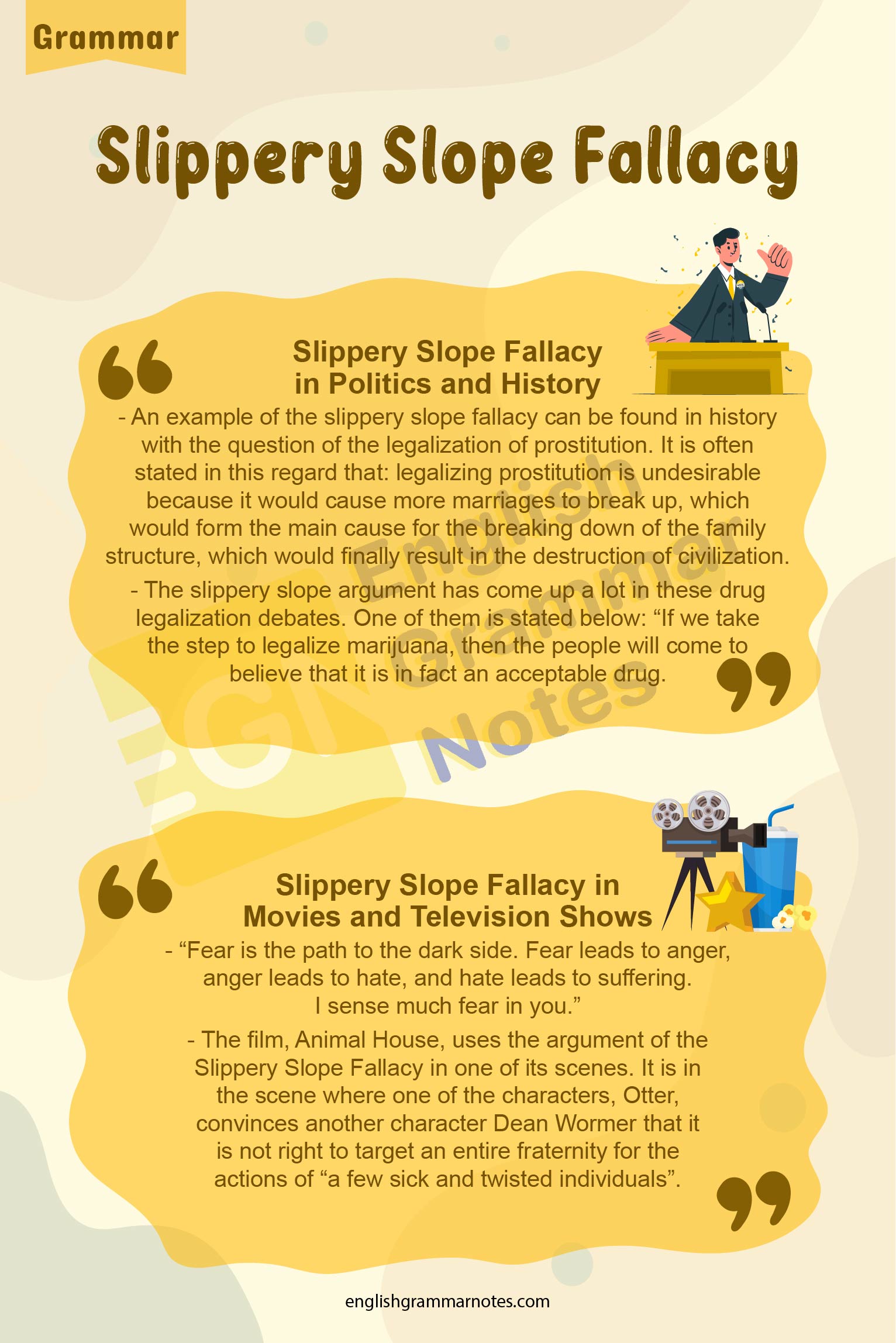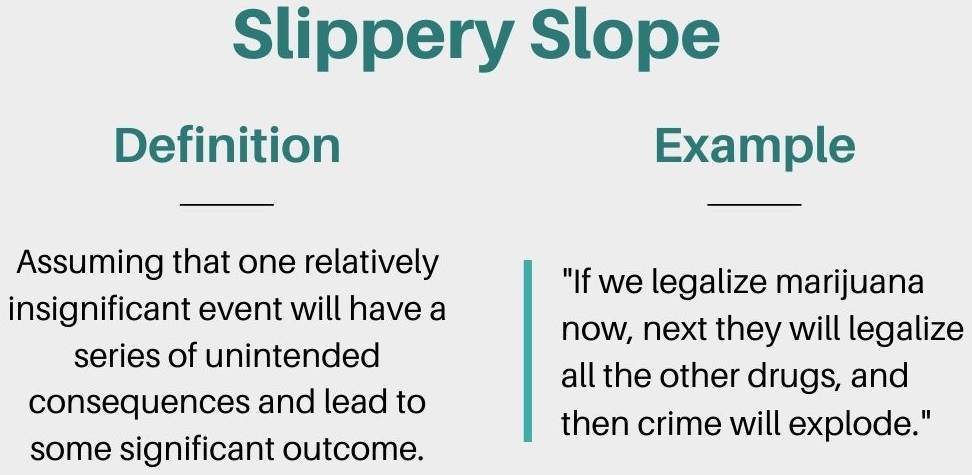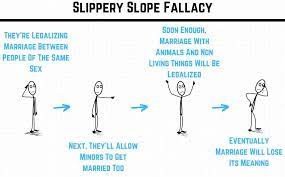Slippery Slope Fallacy Examples: The slippery slope argument relies on making one think that the worst-case scenario of a particular situation that can happen will happen if one chooses to take a particular course of action, even though it might not necessarily be the case. In many cases, the slippery slope fallacy is funny in the real world.
Besides being a common and frequent logical fallacy that is seen in the real world, it finds numerous applications of the slippery slope in various other fields. There are various slippery slope examples in history and various slippery slope examples in movies.
This article will look into detail a few selected examples of the Slippery Slope fallacy being present and used in fields like politics and history and from the entertainment industry things like movies and TV shows. It is very necessary to be kept in mind that the Slippery Slope fallacy is also used as a device in many parts of the entertainment industry.
Slippery Slope Fallacy
- Description and Understanding of Slippery Slope Fallacy
- Examples of Slippery Slope Fallacy in Politics and History
- Examples of Slippery Slope Fallacy in Movies and Television Shows
Description and Understanding of Slippery Slope Fallacy
A slippery slope argument (SSA) present, in logic, critical thinking, political rhetoric, and case law, is the kind of argument wherein a party tries to convince everyone that a relatively minuscule first step would create a domino effect leading to a chain of events related to each other that ultimately culminates in some major significant(usually negative) effect.

The base of the slippery slope argument is formed when a specific argument is under debate and is likely to result in consequences that are not intended. The strength of such an argument solely depends on whether the small step has any actual firepower that may lead to a consequence that is big and has unintended results.
Thus, the core of the basic argument is flawed. Under rigorous scrutiny, the small argument that is supposed to create a chain of larger events will fall apart as they are not based on evidence or information.
Typically, in most logic works and critical textbooks, the slippery slope argument is heavily discussed as a form of fallacy. However, it is also acknowledged that “slippery slope arguments can be used for goof if the slope is real.
It is only possible for the slope to be real if there is good conclusive evidence that the consequences of the initial action will lead to the unintended consequences of a worst-case scenario. In that sense, the slippery slope argument also has its own non-fallacious uses.
Examples of Slippery Slope Fallacy in Politics and History
There are various examples of the slippery slope fallacy that is found in history. By history, one here means in historical topics and not just historical events. The slippery slope argument has been used all through the course of history to keep back many things from progressing forward.
By the use of the slippery slope arguments, the people against certain policies were able to withhold decisions. They portray the worst-case scenario for any situation and, in doing so, introduce an element of fear, thereby pushing the opinion into negative and being against the original argument that might make sense.
Further, the worst-case scenario is mostly not confirmed or true, as it is not based on much evidence. The following are the few examples we have gathered to help understand the slippery slope fallacy:
- An example of the slippery slope fallacy can be found in history with the question of the legalization of prostitution. It is often stated in this regard that: legalizing prostitution is undesirable because it would cause more marriages to break up, which would form the main cause for the breaking down of the family structure, which would finally result in the destruction of civilization.
This is an example of the slippery slope fallacy as the main argument, i.e. the legalization of prostitution said to cause the unintended consequence of the breaking up of families and eventually in the destruction of civilization as we know it.
Thus, in the slippery slope fallacy, the act of prostitution is legal is stated as the event that will trigger the worst-case scenario for that situation. The worst possible scenario, in that case, is the destruction of civilization after the breaking up of families.
- Another big question in history where the slippery slope fallacy is applied is in the question of abortion. A voter stated that: “First we loosen up the laws against abortion. Next, mark my words; we’ll take the option of infanticide in certain severe cases seriously.”
The above quoted text is a clear example of a slippery slope argument as the small step of loosening laws against abortion is supposedly said to be a stepping stone for the ultimate worst-case scenario of permission for infanticide. This again may not be true, and hence this is another example of the slippery slope fallacy.
- The question of legalization of drugs and substances has been a big question in history and politics for a long period of time. The slippery slope argument has come up a lot in these drug legalization debates. One of them is stated below:
“If we take the step to legalize marijuana, then the people will come to believe that it is in fact an acceptable drug.
Further, if that happens, then other states will follow, and that will lead to the legalization of the drug nationwide. In no time, everybody is going to go around doing pot, and no work will be done.”
In the above quote, it is stated that if the drug is legalized, then everybody will start the consumption of the said drug resulting in no work being done. Thus, the step taken in legalizing marijuana will have the ultimate consequence of no work being done.
However, this assumption is a fallacy because it is impossible to theoretically state that the legalization of the drug will lead to no work being done. This argument is not true and will fall to extreme scrutiny as it is not based on any hardline evidence.
Examples of Slippery Slope Fallacy in Movies and Television Shows
The slippery slope fallacy is not just employed and used in circles relating to politics, history or philosophical discussions. It has also penetrated the world of entertainment, namely in movies, television shows, reality shows and even in other forms of entertainment like sports where a worst-case scenario is predicted.
- “Fear is the path to the dark side. Fear leads to anger, anger leads to hate, and hate leads to suffering. I sense much fear in you.”
This quote is a famous example of the Slippery Slope fallacy actually coming true. It is not in many cases that the fallacy comes true, but it is possible for the use of a slippery slope argument to be used in a non-fallacious way.
It is in Star Wars: Episode I – The Phantom Menace, the Jedi Master Yoda utters the words quoted above in a scene from the movie. In the scene, he is shown to be talking to Anakin Skywalker, who would later transform and go on to become the infamous Darth Vader.
The slippery slope comes true as Anakin was always afraid of losing his mother and the people he cared about, the culmination of which led to fits of rage. This led to hate for the Jedi Council and other institutions.
This led to the rise of Darth Vader, and with him came incredible suffering all across the galaxy for all kinds of people as he tried to conquer the galaxies and the Jedi Council.
- The film, Animal House, uses the argument of the Slippery Slope Fallacy in one of its scenes. It is in the scene where one of the characters, Otter, convinces another character Dean Wormer that it is not right to target an entire fraternity for the actions of “a few sick and twisted individuals”.

It is in the scene after this whole confrontation between Otter and Dean Wormer that the usage of Slippery Slope is seen in its full glory.
Otter, in this scene then claims that if ultimately are going to blame his fraternity for the actions of a few, then they must also go on and blame the entire fraternity system that exists, and if they are going to blame the entire fraternity system, they must also blame all of American society in general for the action of the few people who committed wrongs.
- The TV show, Two Broke Girls also uses the Slippery Slope argument in one of its scenes. In the scene where we see the fallacy in action, a character named Max is trying to bring together and rouse a group of tenants to file a class-action lawsuit against their landlord who is not fixing an issue of hot water.
The Slippery Slope lies in the fact that to rally the group of tenants to file the class action lawsuit against their landlord, Max convinces or tries to convince the tenants that the non-presence of hot water in their apartments will lead to the result i.e. in all their children becoming crack addicts.
Thus, in this scene, Max tries to convince the tenants to join him in to file a lawsuit by trying to convince them that if they don’t file a lawsuit to fix the hot water issues, the worst-case scenario of their children becoming drug addicts will come into fruition.
Thus, this article was written for first time learners to understand the concepts of the logical fallacy of the Slippery Slope. We have tried to compose a few examples from history and politics and movies and tv shows to help in the holistic understanding of this concept.


